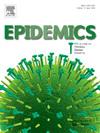Incident COVID-19 infections before Omicron in the U.S.
IF 2.4
3区 医学
Q2 INFECTIOUS DISEASES
引用次数: 0
Abstract
The timing and magnitude of COVID-19 infections are of interest to the public and to public health, but these are challenging to ascertain due to the volume of undetected asymptomatic cases and reporting delays. Accurate estimates of COVID-19 infections based on finalized data can improve understanding of the pandemic and provide more meaningful quantification of disease patterns and burden. Therefore, we retrospectively estimate daily incident infections for each U.S. state prior to Omicron. To this end, reported COVID-19 cases are deconvolved to their likely date of infection onset using delay distributions estimated from the CDC line list. Then, a novel serology-driven model is used to scale these deconvolved cases to account for the unreported infections. The resulting infection estimates incorporate variant-specific incubation periods, reinfections, and waning antigenic immunity. They clearly demonstrate that reported cases failed to reflect the full extent of disease burden in all states. Most notably, infections were severely underreported during the Delta wave, with an estimated reporting rate as low as 6.3% in New Jersey, 7.3% in Maryland, and 8.4% in Nevada. Moreover, in 44 states, fewer than 1/3 of infections eventually appeared as case reports, and there were sustained periods where surges in infections were virtually undetectable through reported cases. This pattern was clearly illustrated by North and South Dakota during the spring of 2021, as well as by several Northeastern states during the Delta wave of late summer that year. While reported cases offered a convenient proxy of disease burden, they failed to capture the full extent of infections and severely underestimated the true disease burden. Our retrospective analysis also estimates other important quantities for every state, including variant-specific deconvolved cases, time-varying case ascertainment ratios, as well as infection-hospitalization and infection-fatality ratios.

在美国欧米克隆之前发生的COVID-19感染事件
COVID-19感染的时间和规模是公众和公共卫生关注的问题,但由于大量未发现的无症状病例和报告延误,这些问题很难确定。根据最终数据对COVID-19感染进行准确估计,可以增进对大流行的了解,并提供更有意义的疾病模式和负担量化。因此,我们回顾性地估计了美国各州在欧米克隆之前的每日感染事件。为此,根据CDC清单估计的延迟分布,将报告的COVID-19病例解卷积到其可能的感染发病日期。然后,使用一种新的血清学驱动模型对这些解卷积病例进行缩放,以解释未报告的感染。由此产生的感染估计包括变异特异性潜伏期、再感染和抗原免疫减弱。它们清楚地表明,报告的病例未能反映所有州疾病负担的全部程度。最值得注意的是,在三角洲波期间,感染严重低估,估计报告率在新泽西州低至6.3%,马里兰州为7.3%,内华达州为8.4%。此外,在44个州,不到三分之一的感染最终以病例报告的形式出现,并且在持续的一段时间里,感染的激增几乎无法通过报告的病例检测到。这种模式在2021年春季的北达科他州和南达科他州以及当年夏末的三角洲波期间的几个东北部州都得到了清楚的说明。虽然报告的病例提供了疾病负担的方便代表,但它们未能捕捉到感染的全部程度,并严重低估了真正的疾病负担。我们的回顾性分析还估计了每个州的其他重要数量,包括变异特异性反卷积病例,随时间变化的病例确定比率,以及感染住院率和感染病死率。
本文章由计算机程序翻译,如有差异,请以英文原文为准。
求助全文
约1分钟内获得全文
求助全文
来源期刊

Epidemics
INFECTIOUS DISEASES-
CiteScore
6.00
自引率
7.90%
发文量
92
审稿时长
140 days
期刊介绍:
Epidemics publishes papers on infectious disease dynamics in the broadest sense. Its scope covers both within-host dynamics of infectious agents and dynamics at the population level, particularly the interaction between the two. Areas of emphasis include: spread, transmission, persistence, implications and population dynamics of infectious diseases; population and public health as well as policy aspects of control and prevention; dynamics at the individual level; interaction with the environment, ecology and evolution of infectious diseases, as well as population genetics of infectious agents.
 求助内容:
求助内容: 应助结果提醒方式:
应助结果提醒方式:


